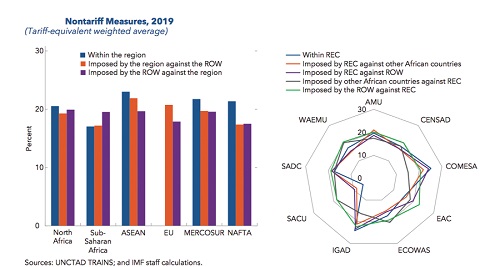The creation of the African Continental Free Trade Area (AfCFTA) in 2018 established the world’s largest free trade area by population (1.3 billion) and with a combined GDP of $3 trillion as of 2022.
The AfCFTA presents its members with an opportunity to take advantage of expanding trade to lift growth and living standards across the entire continent.
This write up examines the prospects for African trade integration in the context of a changing world amid climate change, risks of geopolitical fragmentation, technological progress, and Africa’s prospective demographic boom.
It discusses policies to underpin successful implementation of the AfCFTA that when combined with complementary reforms, would maximise the potential gains from enhanced trade integration in Africa.
Africa’s recorded cross-border trade has grown relatively modestly in recent decades, with limited growth in merchandise trade and an unchanged share of services trade in GDP.
The continent’s exports to the rest of the world are dominated by commodities, while trade within the region is more diversified and includes a larger share of processed goods.
These trade patterns are consistent with the continent’s limited integration in global value chains (GVCs), reflecting its fragmented trade policy landscape marked by multiple regional economic communities, a challenging trade environment with gaps in structural factors such as transport networks, customs and border processes, and access to finance.
At the same time, there appears to be significant informal cross-border trade although it is hard to measure.
These patterns, including the more diversified nature of intra-African trade, reflect the potential for significant gains for African trade from building regional value chains, unifying the trade policy landscape and strengthening the trade environment.
Reduction
AfCFTA implementation will entail large reductions in tariff and non-tariff trade barriers among African countries. These reductions could increase the median merchandise trade flow between African countries by 15 per cent and median real per capita GDP by 1.25 per cent.
If the reductions in tariff and non-tariff barriers are combined with substantial improvements in the trade environment, the payoff to countries would be significantly higher.
The paper finds that comprehensive reforms combined with the AfCFTA implementation could increase the median merchandise trade flow between African countries by 53 per cent and with the rest of the world by 15 per cent and as a result, raise the real per capita GDP of the median African country by more than 10 per cent.
This result resonates with findings in the literature that trade reforms could help reduce extreme poverty by an additional 30–50 million people across the continent.
The creation of the AfCFTA comes at a time when a changing global environment creates both opportunities and challenges for Africa. Greater trade integration can help the continent take advantage of the opportunities provided by technological change and demographic trends and enhance its resilience to shocks such as climate change and geopolitical fragmentation.
Openness
In particular, greater trade openness would help countries adapt to climate change and to strengthen food security, including by improving the availability and affordability of food supplies.
More diversified and broad-based trade would reduce the impact of disruptions in specific markets and products that could result from shifts in global trade patterns. Trade is the principal means through which the emergence of new technologies and digitalisation, in combination with a rapidly growing labour force could create new and higher paying jobs.
Seizing these opportunities will require investment in physical and human capital, a robust macroeconomic and business environment conducive to private sector-led growth, and a modernised social safety net that supports the most vulnerable during the transition to a higher growth trajectory.
Unlocking benefits of regional trade integration in Africa
Initiatives to foster greater economic integration in Africa over several decades culminated in the creation of the African Continental Free Trade Area (AfCFTA) in 2018, with the goal of expanding intra-African trade and promoting economic diversification and industrialisation of its member countries.
The AfCFTA aims to achieve this through the liberalisation of goods and services trade across the continent, trade facilitation by enhancing border processes, and implementation of certain “behind the border” measures.
This paper discusses how implementation of the AfCFTA, when complemented with other reforms could catalyse deeper trade integration both within the African continent and with the rest of the world, thereby embracing the opportunities offered by technological change, a growing working-age population, and a changing global environment.
